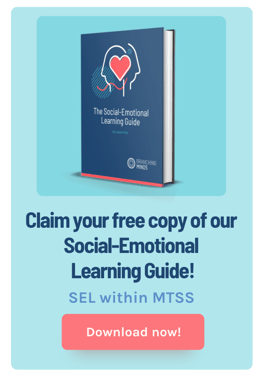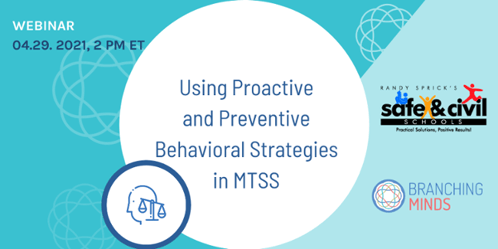This blog was updated by Trudy Bender on September 6, 2022.
Educators are becoming increasingly concerned about their students’ mental health and well-being. Research has shown that isolation and loneliness were often associated with psychological symptoms across childhood and adolescence even before the pandemic.
Now, researchers are reporting findings that indicate that the social distancing and stay-at-home measures implemented at the beginning of the pandemic resulted in increased reports of depression and anxiety among students.
Studies have also shown that these negative impacts are more likely to be amplified for students who were already disadvantaged and marginalized prior to the pandemic (i.e., students of color and from lower socioeconomic backgrounds).
Interestingly, students who felt connected to others throughout the pandemic were less likely to report internalizing symptoms (e.g., depression, anxiety, and stress). In addition to fostering positive connections and relationships, there are several ways that teachers and school staff can offset these negative outcomes.
Below we provide four tips for how educators can support mental health and social-emotional well-being in order to address some of the potential negative impacts of the pandemic and other challenges faced by today’s students.
1. Focus on Relationship Building and Social-Emotional Learning (SEL) in Tier 1
When discussing mental health, educators often focus on those students requiring more intensive interventions and support. However, it's important to support students’ mental health and well-being at all levels within an MTSS model. This includes actively implementing strategies and practices that promote student well-being within the core classroom content.
Most strategies and practices at the Tier 1 level involve preventing behavioral and emotional problems by promoting positive relationships and teaching social-emotional skills.
Positive social relationships with school staff and peers can be a critical protective factor for child and adolescent mental health. Specifically, positive relationships with school staff and teachers can be a protective factor for adolescents with less family support.
Find SEL Programs & Practices That Support Students' Mental Health
Finding SEL programs and practices that are focused on relationship building can be a great place to start at the Tier 1 level of support. Harmony SEL and Random Acts of Kindness are examples of free and evidence-based prevention programs that can be implemented at the Tier 1 level that focus on building positive relationships.
These promotive and preventive practices should also be integrated into academic lessons and instruction. For example, using small group discussions and peer groups for problem-solving and collaboration can help engage students and build positive social skills (to learn more about this approach check out this great blog post).
Talking about the perspectives, emotions, and feelings of characters within stories and drawing connections between literature and social studies content and students’ own experiences can be another great way to integrate SEL into academic content.
When engaging in these discussions, teachers shouldn’t be afraid to talk about emotions and feelings in an open and supportive way. Some educators may avoid these kinds of topics because they are unsure how to respond to the emotional reactions of their students, or they have difficulty expressing and addressing their own emotions.
Support and professional development might be required for some educators to help them feel comfortable addressing these types of issues in their classrooms. For more information and strategies on how to talk about emotions in the classroom, check out this interview with an SEL expert on the topic.
|
Related Resources: ➡️ Best Practices of Data Analysis and Differentiation for Tier 1 in MTSS |
2. Use Validated Criteria and Assessments to Identify Students
Using valid and reliable assessments is always important in any MTSS practice; however, it is especially important when evaluating students’ mental health and well-being. Sometimes educators perceive social-emotional and behavioral assessments as clinical assessments that can be used to identify internalizing or externalizing disorders.
There is an important distinction between assessments that ask about students’ behaviors such as social skills, self-regulation, cooperation, and problem-solving, and their psychological symptoms, such as anxiety, depression, self-harm, and physical aggression.
Utilizing Behavioral and SEL Universal Screeners
Behavioral and SEL universal screeners can be used by teachers and students to identify who may be at an increased risk for mental health problems, however, they do not mean the student has psychological symptoms or a mental health condition. This means the results from SEL or behavioral assessments can be used to identify students needing additional SEL or behavioral support or to understand school—and grade-level patterns and trends, but they should not be used to label or diagnose students.
Often, specialists, such as school psychologists, social workers, and counselors should be the ones administering any kind of mental health or psychological assessment. This is usually done once the student has taken an initial screener and additional insight and observations have been provided by the classroom teacher, caregivers, and other adults that work with the student.
3. Have Trained Staff Members Implement Tier 2 and Tier 3 Interventions
Students at an increased risk for mental health problems who are showing early signs or symptoms of mental health disorders should be receiving evidence-based programming or interventions. These are typically not the type of interventions that can be implemented by simply reading and following instructions in a manual or on a website.
They also are not activities students can complete independently; guidance from trained professionals on the techniques or methods being used within the program and intervention is often required.
Sometimes teachers or paraprofessionals can be trained on how to implement components of the program alongside a specialist with additional training and expertise. In other words, the classroom teacher or other staff member is involved in the implementation, but it is still overseen by a trained professional.
Learn more about Tier 2 & Tier 3
➡️ What You Need To Know About Utilizing Tier 2 in MTSS
➡️ Building an Engaging Tier 3 Support in MTSS
Use the Right Programs Developed by Trained Professionals
When working with at-risk students or students identified as having a psychological disorder, schools should avoid homegrown programs and interventions and instead opt for ones that have been developed by trained professionals, such as psychologists and psychiatrists, with a focus on school-appropriate supports.
The following websites are great resources for findings on evidence-based mental health programs that can be implemented in school contexts by trained professionals:
- CEBC: California Evidence-Based Clearinghouse for Child Welfare
- OJJDP: Model Programs Guide
- Blueprints for Healthy Youth Development: Experimentally Proven Programs
- National Institute of Justice: Juvenile Programs
4. Make Sure There is Consistency and Communication Across Levels of Support
Promotive and preventive practices being done at the Tier 1 level are also essential for those students who are receiving Tier 2 or Tier 3 levels of support as well as additional mental health services. There needs to be consistency across these contexts and areas of support in order for these programs to be successful. District and campus level MTSS teams can help coordinate professional development so that all staff members are using common language and strategies to support SEL, with additional instruction for the teachers of students with more intense needs.
For example, if a behavior coach or specialist teaches student-specific strategies for regulating and expressing emotions, the student’s classroom teachers should be made aware of these strategies and promote their use in the classroom as well. The classroom environment needs to be supportive and inclusive in order for the skills being taught in smaller groups or one-on-one to transfer and stick.
The Importance of Ongoing Communication When Supporting Students' Mental Health
 The coordination and consistency across levels of support may also require communication between outside mental health providers and the child’s school support team. It's important for these external providers to have access to relevant data on the student and vice versa.
The coordination and consistency across levels of support may also require communication between outside mental health providers and the child’s school support team. It's important for these external providers to have access to relevant data on the student and vice versa.
For example, a student’s therapist might request information about behavior incidents and office referrals to know what kinds of issues are occurring at school and the impact that suggested strategies are having on the student’s behavior. The student’s school support team will also benefit from appropriate basic information about the student’s intervention program. It is legally and ethically non-negotiable to protect confidentiality and secure written permission when sharing information about a student’s mental health. At the same time, it is essential that schools and outside providers collaborate appropriately to best support the child.
When developing or adapting a school-based intervention plan for a student with mental health needs, it is best practice to hold a multi-disciplinary meeting that includes the school specialist overseeing the student’s support plan, classroom teacher(s), wrap-around service providers, natural supporters (parent, guardian, coach, other trusted adults) and the student as appropriate. A true MTSS approach that addresses the needs of the whole child, including mental health needs, raises the likelihood that the student will gain the skills needed for success not just in school but in life.
Check out this on-demand webinar on
Behavioral Strategies in MTSS 
Interested in Learning How to Support the Whole Child with Branching Minds?Branching Minds makes MTSS easy, efficient, and effective by bringing together all of the components of MTSS so teachers can collaboratively problem-solve and support all students’ holistic needs. Our system-level solution helps schools improve students’ outcomes across academics and behavior. Our platform supports teachers with Behavior and SEL in the following ways: ✅ Assessing SEL Needs with the DESSA
✅ Understand Students Perception of their Own SEL Competence with the SECA ✅ Leveraging SEL Screeners for Tiering ✅ More effective problem-solving ✅ Finding the Right Evidence-based Interventions & Accommodations for Each Learner ✅ Creating Intervention Plans and Monitoring Daily & Weekly Progress in Behavior/SEL ✅ Logging & Monitoring Behavior Incidents ✅ Pattern Matching Behavior Incidents Across Groups
|

About the author
Dr. Essie Sutton
Essie Sutton is an Applied Developmental Psychologist and the Director of Learning Science at Branching Minds. Her work brings together the fields of Child Development and Education Psychology to improve learning and development for all students. Dr. Sutton is responsible for studying the impacts of the Branching Minds on students’ academic, behavioral, and social-emotional outcomes. She also leverages MTSS research and best practices to develop and improve the Branching Minds platform.

Your MTSS Transformation Starts Here
Enhance your MTSS process. Book a Branching Minds demo today.

















.png?width=716&height=522&name=Addressing%20Foundational%20Reading%20Skills%20in%20MTSS%20(preview).png)
.png?width=716&height=522&name=Understanding%20Literacy%20Basics%20(Preview).png)
